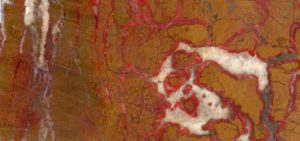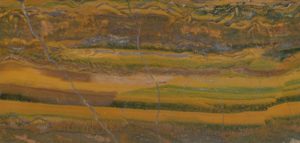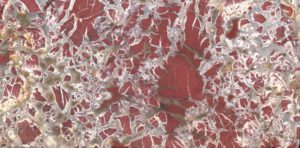Referred to as diaspri di Sicilia in Italian, Sicilian jaspers are very hard and occur in a multitude of colour and pattern variations, making them ideal stones for decorating ornaments. Today they are no longer commercially quarried, but around 300 varieties of Sicilian jasper have been identified in the Baroque churches of Sicily. Reaching their heyday in the 17th and 18th centuries, Sicilian jaspers were mined mainly in the province of Palermo, particularly near the towns of Giuliana and Bisacquino.
Jasper is a variety of opaque cryptocrystalline quartz formed by silica-rich fluids percolating through fissures in limestone rocks. They come in an abundance of colours, with the red variations attributed to the presence of hematite and yellow to the presence of goethite. Brecciated jasper, which has a fragmented appearance, has formed due to movements of the rock, perhaps triggered by earthquakes. Like agates, jaspers can range from opaque to translucent and have a vitreous lustre.
Thanks to the comprehensive collection formed by the Roman lawyer Faustino Corsi (1771-1846), it is possible for specialists to identify varieties of Sicilian jasper used on decorative pieces. Present in The Courtauld’s Baroque frame are inlays of diaspro di Palermo, which is a brecciated jasper with orange, red and colourless fragments (see Corsi 776 below), and two types of diaspro di Giuliana, one of which is a brecciated red jasper with rims of opaque white quartz (see Corsi 745 below), and the other is a banded version of yellow and green layers (see Corsi 764 below).





